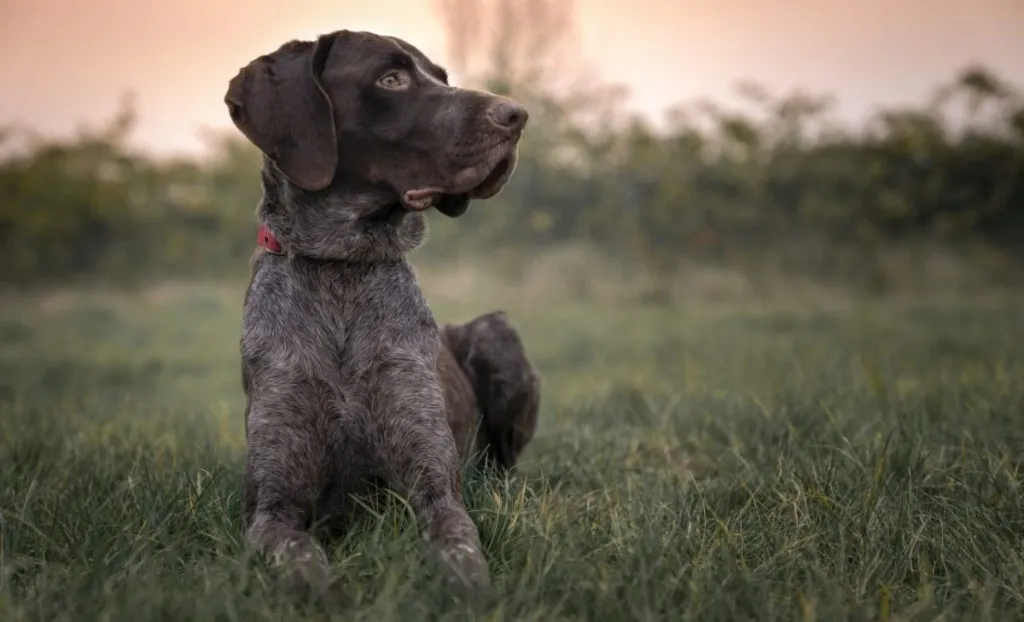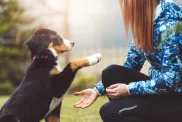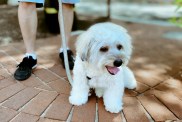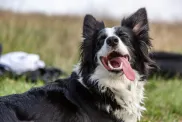The German Shorthaired Pointer, often referred to as the GSP, is a versatile and energetic breed known for its athleticism and intelligence. Originating in Germany, this breed was developed in the 19th century with the intention of creating a multipurpose hunting dog capable of working on both land and water.
This beloved breed is medium to large-sized with an athletic build. They have a sleek coat that comes in various colors and patterns. The coat is low maintenance and provides protection against different weather conditions.
Renowned for their versatility, German Shorthaired Pointers excel in various roles. This includes hunting, tracking, retrieving, and even as a family companion. They possess a keen sense of smell, exceptional stamina, and an instinct for hunting and pointing game. Their intelligence and trainability make them suitable for a wide range of activities, from competitive field trials to obedience and agility competitions.
German Shorthaired Pointers make loyal and affectionate family pets. Known for their friendly and outgoing nature, these dogs form strong bonds with their human companions. They are generally good with children and can coexist well with other pets if properly socialized.
This breed requires regular exercise and mental stimulation to expend its abundant energy. Daily activities such as brisk walks, jogs, games, or engaging in canine sports are essential.
Quick Facts
- Origin: Germany
- Purpose: Hunting
- Height: 22-25 inches (male), 21-23 inches (female)
- Weight: 55-70 pounds (male), 45-60 pounds (female)
- Lifespan: 12-14 years
- Temperament: Friendly, intelligent, eager to please, active
- Grooming needs: Moderate
- Exercise requirements: High
- Training: Relatively easy to train, but can be stubborn at times
- Health: Hip dysplasia, elbow dysplasia, eye problems, bloat
- Famous owners of German Shorthaired Pointers (GSPs) include actor Bradley Cooper and country music stars Tim McGraw and Chase Bryant.
- A German Shorthaired Pointer made a small cameo appearance in the live-action version of Disney’s 101 Dalmations (1996).
German Shorthaired Pointer Dog Breed Pictures
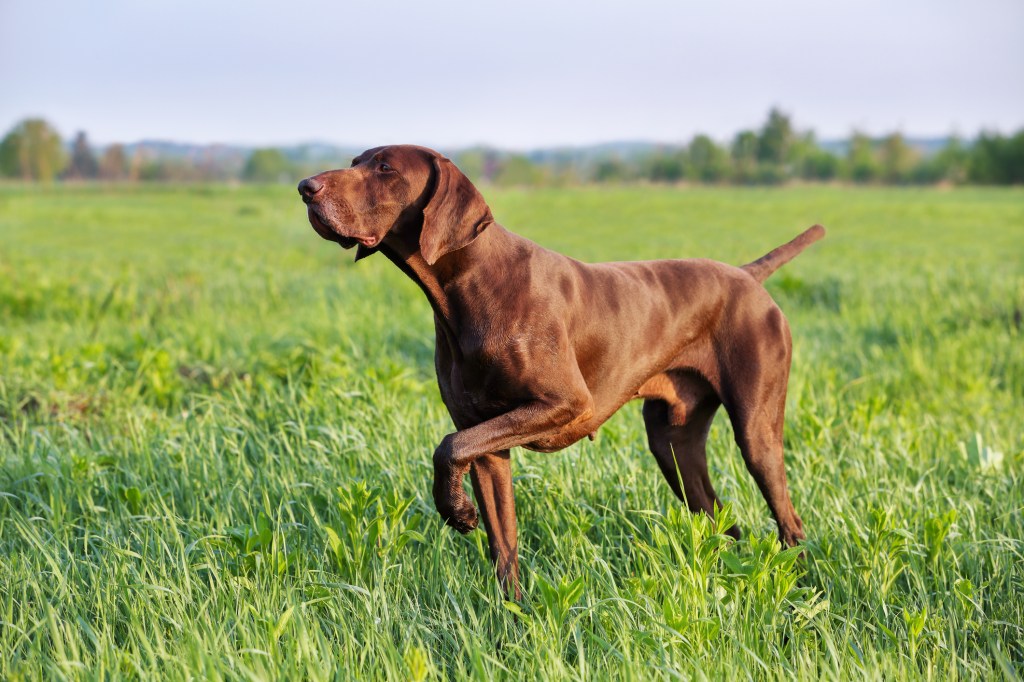
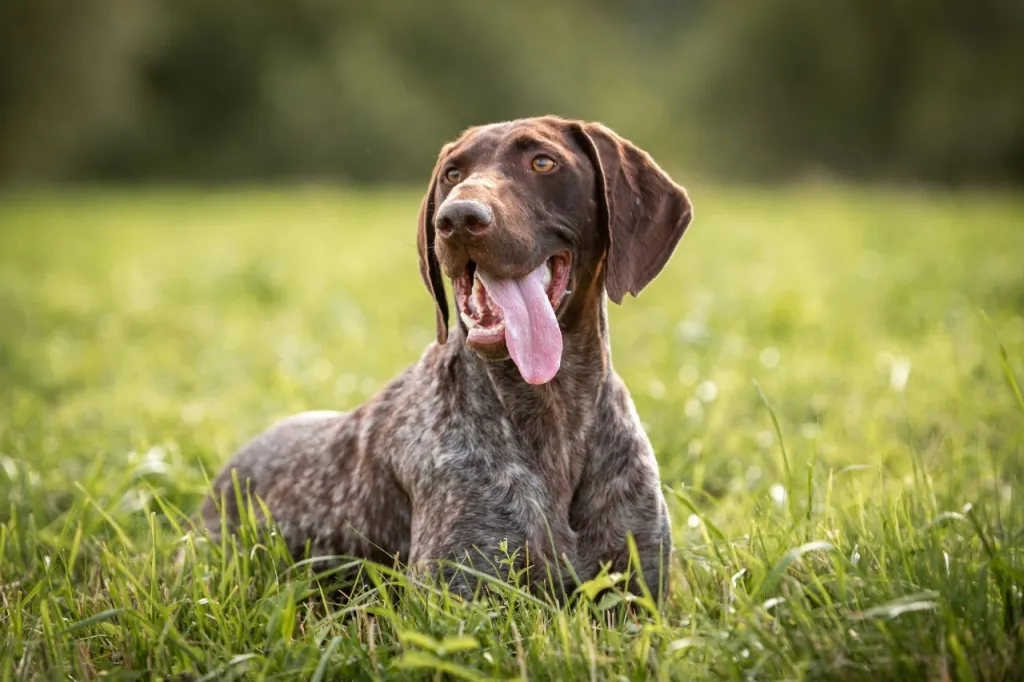

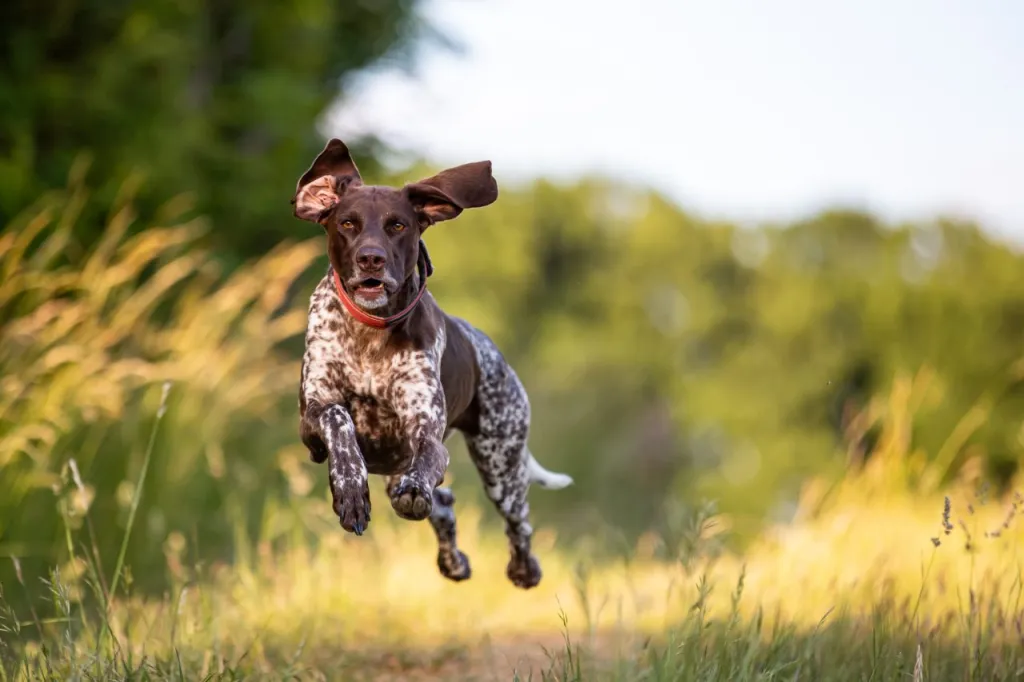
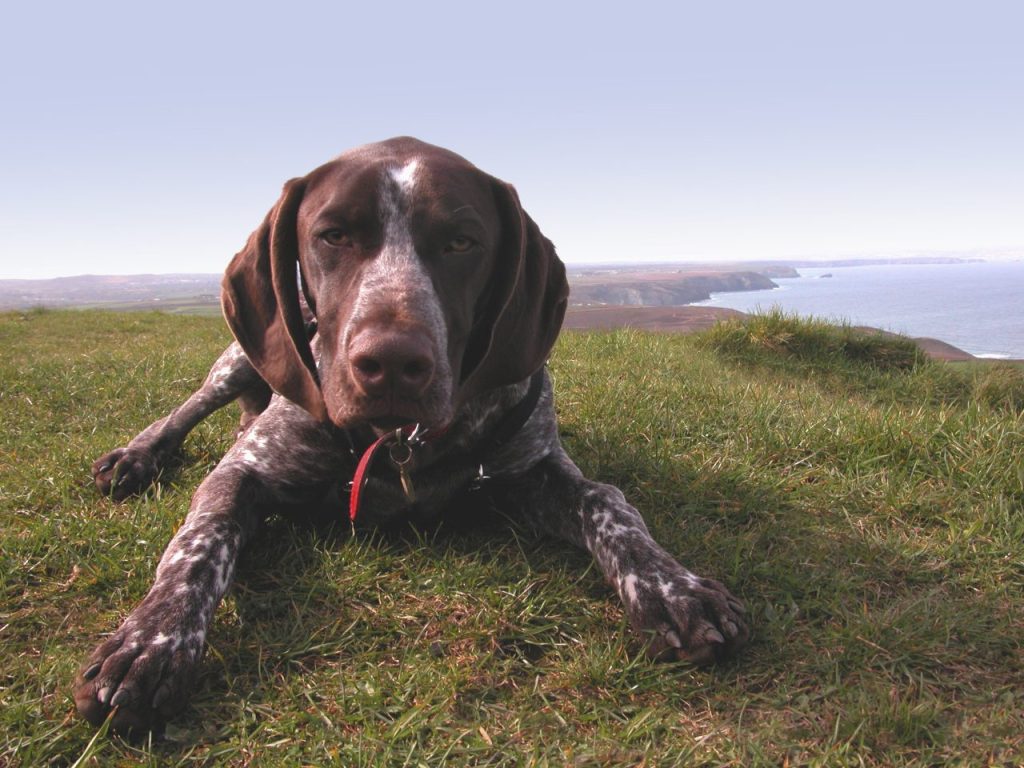
Adaptability
-
Adapts Well To Apartment Living
Looking for the best dog for your apartment? Contrary to popular belief, the suitability of dogs who adapt well to apartment living goes beyond its size. Apartment dwellers have a myriad of dog breeds to choose from as potential companions, with various factors to consider. Some large breeds can adapt well to apartment living and have lower activity levels. Others may require more space and possess higher energy levels. On the other hand, certain small dog breeds with abundant energy can still find contentment with indoor playtime or brisk walks.
However, when selecting a dog that adapts well apartments, it is essential to prioritize your neighbors. Opting for a pet that doesn’t excessively bark and behaves politely when encountering others in shared spaces like is crucial for maintaining a harmonious apartment environment.
In high-rise settings, it’s worth noting that numerous small dogs may exhibit a propensity for high energy and frequent barking. This makes them less suitable for apartment living. Therefore, desirable qualities in an apartment dog encompass being quiet, low-energy, and displaying polite behavior towards other residents.
Factors To Consider When Choosing A Dog For An Apartment
When considering dogs that adapt well to apartments, size alone should not be the sole determinant. Apartment dwellers have a wealth of dog breeds to choose from as potential furry companions. It’s important to remember that the size of your living space is just one factor to consider. While some larger breeds can adapt well to apartment living, with lower, others may require more space and have higher energy levels, making them less suitable for smaller apartments. Conversely, certain small dog breeds with higher energy levels can still thrive in apartments, finding contentment through indoor playtime or brisk walks. However, it is crucial to consider your neighbors’ comfort when selecting a dog. Opt for a pet that doesn’t bark excessively and behaves politely when interacting with others in shared spaces.
Therefore, it’s important to prioritize qualities such as being quiet, low-energy, calm indoors, and exhibiting good manners when living in close proximity to other residents. By considering these factors, you can find a dog that will adapt well to apartment living and create a harmonious living environment for everyone involved.
-
Good For Novice Owners
Some dogs are simply easier than others; they take to training better and are fairly easygoing. They’re also resilient enough to bounce back from your mistakes or inconsistencies.
Dogs who are highly sensitive, independent thinking, or assertive may be harder for a first-time dog parent to manage. You’ll get your best match if you take your dog-owning experience into account as you choose your new pooch.
If you’re new to dog parenting, take a look at 101 Dog Tricks and read up on how to train your dog!
-
Sensitivity Level
Some dogs will let a stern reprimand roll off their backs, while others take even a dirty look to heart. Low-sensitivity dogs, also called “easygoing,” “tolerant,” “resilient,” and even “thick-skinned,” can better handle a noisy, chaotic household, a louder or more assertive owner, and an inconsistent or variable routine. Do you have young kids, throw lots of dinner parties, play in a garage band, or lead a hectic life? Go with a low-sensitivity dog.
-
Tolerates Being Alone
Some breeds bond very closely with their family and are more prone to worry or even panic when left alone by their owner. An anxious dog can be very destructive–barking, whining, chewing, and otherwise causing mayhem. These breeds do best when a family member is home during the day or if you can take the dog to work.
-
Tolerates Cold Weather
Breeds with very short coats and little or no undercoat or body fat, such as Greyhounds, are vulnerable to the cold. Dogs with a low cold tolerance need to live inside in cool climates and should have a jacket or sweater for chilly walks. You can find a great jacket for your dog here!
-
Tolerates Hot Weather
Dogs with thick, double coats are more vulnerable to overheating. So are breeds with short noses, like Bulldogs or Pugs, since they can’t pant as well to cool themselves off. If you want a heat-sensitive breed, your dog will need to stay indoors with you on warm or humid days, and you’ll need to be extra cautious about exercising your dog in the heat.
All-around friendliness
-
Affectionate With Family
When it comes to unconditional love and unwavering loyalty, few animals can rival the affectionate nature of dogs. These remarkable creatures have earned their reputation as man’s best friend, and many breeds are particularly renowned for their love and devotion to their families. With their warm hearts and wagging tails, affectionate family dogs enrich the lives of their owners in countless ways.
One such breed known for its affectionate demeanor is the Golden Retriever. With their gentle temperament and friendly disposition, Golden Retrievers form deep bonds with their families. They eagerly participate in family activities, whether it’s a game of fetch in the yard or cuddling on the couch during a movie night. Their expressive eyes and ever-wagging tails are a testament to the joy they feel in the presence of their loved ones.
Another family-favorite breed is the Labrador Retriever. Renowned for their playful and patient nature, Labradors are excellent companions for children and adults alike. They readily engage in playtime with the kids, showcasing their boundless energy and enthusiasm. But when the day winds down, they seamlessly transition into loving and gentle cuddle buddies, comforting their family members with their warm presence.
Beyond specific breeds, mixed-breed dogs also have a special place in the hearts of families seeking affectionate companions. The shelter dogs, in particular, form deep connections with their adoptive families. They seem to understand the second chance they’ve been given and repay it with endless love and gratitude.
How To Know If A Dog Is Good With Families
The affectionate nature of family dogs extends beyond play and cuddles. Dogs have a remarkable ability to sense their owner’s emotions, offering comfort and support during difficult times. Whether it’s a wagging tail after a long day at work or a sympathetic nuzzle during moments of sadness, they prove time and again that they are attuned to their family’s needs.
It is important to note that not all dogs of the same breed will be equally affectionate. Some dogs may be more independent or aloof, while others may be more clingy or demanding of attention. The best way to find out how affectionate a dog is is to meet them in person and interact with them.
-
Kid-Friendly
Being gentle with children, sturdy enough to handle the heavy-handed pets and hugs they can dish out, and having a blasé attitude toward running, screaming children are all traits that make a kid-friendly dog. You may be surprised by who’s on that list: Fierce-looking Boxers are considered good with children, as are American Staffordshire Terriers (which are considered Pit Bulls). Small, delicate, and potentially snappy dogs such as Chihuahuas aren’t always so family-friendly.
**All dogs are individuals. Our ratings are generalizations, and they’re not a guarantee of how any breed or individual dog will behave. Dogs from any breed can be good with children based on their past experiences, training on how to get along with kids, and personality. No matter what the breed or breed type, all dogs have strong jaws, sharp pointy teeth, and may bite in stressful circumstances. Young children and dogs of any breed should always be supervised by an adult and never left alone together, period.
-
Dog Friendly
Friendliness toward dogs and friendliness toward humans are two completely different things. Some dogs may attack or try to dominate other dogs, even if they’re love-bugs with people; others would rather play than fight; and some will turn tail and run. Breed isn’t the only factor. Dogs who lived with their littermates and mother until at least six to eight weeks of age and who spent lots of time playing with other dogs during puppyhood, are more likely to have good canine social skills.
-
Friendly Toward Strangers
Stranger-friendly dogs will greet guests with wagging tails and nuzzles; others are shy, indifferent, or even aggressive. However, no matter what the breed, a dog who was socialized and exposed to lots of different types, ages, sizes, and shapes of people as a puppy will respond better to strangers as an adult. Remember that even friendly dogs should stay on a good, strong leash like this one in public!
Health And Grooming Needs
-
Amount Of Shedding
If you’re going to share your home with a dog, you’ll need to deal with some level of dog hair on your clothes and in your house. However, shedding does vary greatly among the breeds. Some dogs shed year-round, some “blow” seasonally, some do both, and some shed hardly at all. If you’re a neatnik, you’ll need to either pick a low-shedding breed or relax your standards. To help keep your home a little cleaner, you can find a great de-shedding tool here!
-
Drooling Potential
Drool-prone dogs may drape ropes of slobber on your arm and leave big, wet spots on your clothes when they come over to say hello. If you’ve got a laid-back attitude toward slobber, fine; but if you’re a neatnik, you may want to choose a dog who rates low in the drool department.
-
Easy To Groom
Some breeds are brush-and-go dogs; others require regular bathing, clipping, and other grooming just to stay clean and healthy. Consider whether you have the time and patience for a dog who needs a lot of grooming, or the money to pay someone else to do it.
-
General Health
Due to poor breeding practices, some breeds are prone to certain genetic health problems, such as hip dysplasia. This doesn’t mean that every dog of that breed will develop those diseases; it just means that they’re at an increased risk.
If you’re adopting a puppy, it’s a good idea to find out which genetic illnesses are common to the breed you’re interested in. You may also want to ask if your shelter or rescue has information about the physical health of your potential pup’s parents and other relatives.
-
Potential For Weight Gain
Some breeds have hearty appetites and tend to put on weight easily. As in humans, being overweight can cause health problems in dogs. If you pick a breed that’s prone to packing on pounds, you’ll need to limit treats, make sure they get enough exercise, and measure out their daily food servings into regular meals rather than leaving food out all the time.
Ask your vet about your dog’s diet and what they recommend for feeding your pooch to keep them at a healthy weight. Weight gain can lead to other health issues or worsen problems like arthritis.
-
Size
Get ready to meet the giants of the doggy world! Large dog breeds aren’t just big balls of fluff, they’re like loving, oversized teddy bears on a mission to steal your heart. Need some convincing? Let’s dive into the awesome benefits of owning one!
First things first, these pooches are a living security system! With their impressive size and thunderous barks, they’ll have any would-be intruder running for the hills. Talk about peace of mind! Plus, who needs an alarm when you’ve got a furry giant protecting your castle?
But that’s not all. Large dog breeds are all about loyalty and devotion. They’ll stick by your side through thick and thin, becoming your most dedicated bestie. Their love knows no bounds! When you have a giant fluffball showing you unconditional love, you’ll feel like the luckiest human on the planet.
Now, let’s talk about their talents. These big fellas are the ultimate working partners. With brains and brawn, they’re up for any challenge. From search and rescue missions to lending a helping paw to those in need, these dogs are superheroes in fur coats. They’ll make you proud every step of the way!
Don’t let their size fool you—these gentle giants have hearts as big as their paws. They’re incredible with kids and other pets, spreading their love like confetti. Their patience and kindness make them perfect family pets, ensuring harmony in your household.
Oh, and get ready to break a sweat! These dogs are fitness enthusiasts, and they’ll keep you on your toes. Daily walks, jogs, and play sessions will not only keep them happy and healthy but will also give you a reason to ditch the couch and join in on the fun. It’s a win-win situation!
So, if you’re ready for a dose of big love, go ahead and consider a large dog breed. They’re the best wing-dog you could ever ask for, ready to make your life a thousand times more exciting, loving, and downright awesome! Get ready for the big adventure of a lifetime!
Trainability
-
Easy To Train
Easy-to-train dogs are more adept at forming an association between a prompt (such as the word “sit”), an action (sitting), and a consequence (getting a treat) very quickly. Other dogs need more time, patience, and repetition during training.
Many breeds are intelligent but approach training with a “What’s in it for me?” attitude, in which case you’ll need to use rewards and games to teach them to want to comply with your requests.
Related:
10 Fun, Impressive Tricks You Can Teach Any Dog
-
Intelligence
Dogs who were bred for jobs that require decision making, intelligence, and concentration, such as herding livestock, need to exercise their brains, just as dogs who were bred to run all day need to exercise their bodies. If they don’t get the mental stimulation they need, they’ll make their own work–usually with projects you won’t like, such as digging and chewing. Obedience training and interactive dog toys are good ways to give a dog a brain workout, as are dog sports and careers, such as agility and search and rescue.
-
Potential For Mouthiness
Common in most breeds during puppyhood and in Retriever breeds at all ages, mouthiness means a tendency to nip, chew, and play-bite (a soft, fairly painless bite that doesn’t puncture the skin). Mouthy dogs are more likely to use their mouths to hold or “herd” their human family members, and they need training to learn that it’s fine to gnaw on chew toys, but not on people. Mouthy breeds tend to really enjoy a game of fetch, as well as a good chew on a toy that’s been stuffed with kibble and treats.
-
Prey Drive
Dogs with a high prey drive have an instinctive desire to stalk, capture, and prey upon potential food sources. Dogs who were bred to hunt, such as Terriers, have an inborn desire to chase — and sometimes kill — other animals. Anything whizzing by — such as cats, squirrels, and perhaps even cars — can trigger that instinct.
How to address a high prey drive
Off-leash adventures are too great a temptation for pups who will wander and hunt. Dogs who like to chase need to be leashed. And, even on a leash, you may experience your dog pulling on the leash to reach rodents or birds in their sight. Otherwise, these pups should be kept in a fenced area when outdoors. If your pup has a high prey drive, you’ll need a high, secure fence in your yard.
These breeds generally aren’t a good fit for homes with smaller pets that can look like prey, such as cats, hamsters, or small dogs. Breeds that were originally used for bird hunting, on the other hand, generally won’t chase, but you’ll probably have a hard time getting their attention when there are birds flying by.
Other behavioral concerns
Observing your dog’s prey drive, which is instinctual and biologically-rooted, is not the same as observing aggression. Much aggression is born of fear and anxiety, especially in the case of dog aggression toward humans.
The tendency to wander, even into oncoming traffic, can produce diasterious results for pups with predatory instincts. It can also lead to pups being bitten by snakes or attacked by other wild animals they may pursue while on the hunt.
-
Tendency To Bark Or Howl
Some breeds sound off more often than others. When choosing a breed, think about how often the dog vocalizes. Learn more about breeds with a tendency to bark or howl.
If you’re considering a hound, would you find their trademark howls musical or maddening? If you’re considering a watchdog, will a city full of suspicious “strangers” put your pup on permanent alert? Will the local wildlife literally drive your dog wild? Do you live in housing with noise restrictions? Do you have neighbors nearby? Then you may wish to choose a quieter dog.
-
Wanderlust Potential
Some breeds are more free-spirited than others. Nordic dogs such as Siberian Huskies were bred to range long distances, and given the chance, they’ll take off after anything that catches their interest. And many hounds simply must follow their noses–or that bunny that just ran across the path–even if it means leaving you behind.
Exercise needs
-
Energy Level
High-energy dogs are always ready and waiting for action. Originally bred to perform a canine job of some sort, such as retrieving game for hunters or herding livestock, they have the stamina to put in a full workday. They need a significant amount of exercise and mental stimulation, and they’re more likely to spend time jumping, playing, and investigating any new sights and smells.
Low-energy dogs are the canine equivalent of a couch potato, content to doze the day away. When picking a breed, consider your own activity level and lifestyle, and think about whether you’ll find a frisky, energetic dog invigorating or annoying.
-
Intensity
A vigorous dog may or may not have high energy, but everything they do, they do with vigor: they strain on the leash (until you train them not to), try to plow through obstacles, and even eats and drinks with great big gulps. These dynamos need lots of training to learn good manners, and may not be the best fit for a home with young kids or someone who’s elderly or frail. A low-vigor dog, on the other hand, has a more subdued approach to life.
-
Exercise Needs
Some breeds do fine with a slow evening stroll around the block. Others need daily, vigorous exercise, especially those that were originally bred for physically demanding jobs, like herding or hunting.
Without enough exercise, these breeds may put on weight and vent their pent-up energy in ways you don’t like, such as barking, chewing, and digging. Breeds that need a lot of exercise are good for outdoorsy, active people, or those interested in training their dog to compete in a high-energy dog sport, such as agility.
-
Potential For Playfulness
Some dogs are perpetual puppies — always begging for a game — while others are more serious and sedate. Although a playful pup sounds endearing, consider how many games of fetch or tag you want to play each day, and whether you have kids or other dogs who can stand in as playmates for the dog.
German Shorthaired Pointer Overview
The German Shorthaired Pointer, also known as the GSP, is a versatile and elegant sporting breed that excels both as a hunting dog and a loving family companion. With his exceptional hunting skills, he can track and retrieve various types of game, including feathered and furred prey, and even trail deer. In the evening, he enjoys spending time with the family, playing with the kids, or snuggling up on the sofa. If you’re not into hunting, he’s always up for a hike or jog by your side.
Slightly smaller than a Pointer, the GSP possesses a distinctive and regal appearance. His head is gracefully chiseled, adorned with dark almond-shaped eyes that radiate intelligence and a good-humored expression. His large, dark nose adds to his charm. The breed’s broad, dropped ears are set high and lie flat against the head. However, the most striking feature of the GSP is his short, dense, and sleek coat, which comes in solid liver or liver and white, often with patching, ticking, or roan patterns. The tail is typically docked, leaving about 40 percent of its original length.
This energetic and intelligent dog thrives on both work and play. He cherishes human companionship and forms a special bond with children, although he may be a bit boisterous for younger ones. The GSP dislikes being left alone for extended periods and may exhibit signs of anxiety or engage in destructive behavior if deprived of regular companionship and exercise. While he barks at strangers to alert his family, he is not typically aggressive. Males tend to be more outgoing and display more assertive hunting instincts compared to females.
The muscular GSP requires a significant amount of exercise to channel his energy. Plan to provide him with one to two hours of physical activity each day. With his webbed feet and water-resistant coat, he particularly enjoys swimming and is a natural water dog. If you have a pool, you can expect him to join you in the water. GSPs are eager to please their owners and respond well to praise, play, and food rewards. They are generally not stubborn and quickly grasp new exercises. However, maintaining their focus during training can be a challenge as they can easily become bored. Remarkably, the GSP is one of the few hunting breeds capable of performing a wide range of gundog tasks, including pointing and retrieving. Whether it’s upland birds, waterfowl, rabbits, raccoons, or even deer, the GSP demonstrates unwavering reliability and unwavering commitment to fulfill any task asked of him.
The German Shorthaired Pointer is a stylish and versatile breed, combining exceptional hunting abilities with a friendly and affectionate nature. He is a reliable hunting partner and a devoted family companion, always ready to please and bring joy to those around him.
German Shorthaired Pointer History
The German Shorthaired Pointer has a history dating back to the 17th century, but the breed we know today was specifically developed in the mid- to late nineteenth century to be a versatile hunting dog. The early predecessors of the GSP were known as German Pointers or German Bird Dogs, resulting from crosses between Spanish Pointers and Bloodhounds. These crosses produced a large hound-like dog with a keen sense of smell. Hunters sought dogs with obedient personalities, but they also desired style and elegance to accompany their scenting abilities. To add style, Pointers from England were introduced, creating a dog that excelled both on land and in water.
Prince Albrecht zu Solms-Braunfeld of the Royal House of Hanover played a significant role in encouraging breeders to prioritize function over form when selecting early specimens. As a result, a lean, athletic, and responsive hunting dog emerged, showcasing intelligence and affection as a companion.
The first German Shorthair arrived in the United States in 1925, imported by Dr. Charles Thornton of Montana, who went on to breed them. Merely five years later, the breed gained recognition from the American Kennel Club (AKC), with Greif v.d. Fliegerhalde being the first registered German Shorthair with the AKC.
World War II had a significant impact on the breeding of German Shorthaired Pointers. Many breeders concealed their best dogs, including GSPs, along with other valuable possessions, as the war drew to a close. Some of these dogs were sent to Yugoslavia for safekeeping, but due to political circumstances, West German breeders faced challenges in rebuilding the breed with a limited gene pool.
Meanwhile, in the United States, GSPs experienced remarkable progress. The 1950s saw significant advancements for the breed, and many consider 1968 as the peak year for German Shorthaired Pointers in the US. In that year, three out of the top four finishers at the AKC National Field Trial Championship had already achieved their conformation championships.
Beyond their hunting abilities, GSPs have inspired writers to feature the breed in their works. Robert B. Parker, known for his Spenser mystery series, prominently features three solid-liver German Shorthairs named Pearl. Rick Bass wrote “Colter: The True Story of the Best Dog I Ever Had,” recounting his experiences living and hunting with a German Shorthair in Montana. Additionally, sportswriter Mel Wallis wrote “Run, Rainey, Run,” chronicling his relationship with his intelligent and versatile hunting German Shorthaired Pointer.
Today, the German Shorthaired Pointer holds the 19th position among the 155 breeds and varieties recognized by the AKC, reflecting its popularity and standing among dog enthusiasts.
German Shorthaired Pointer Size
Male German Shorthaired Pointers typically stand 23 to 25 inches tall at the shoulder and weigh between 55 to 70 pounds. Females, on the other hand, have a slightly smaller stature, standing 21 to 23 inches tall at the shoulder and weighing around 45 to 60 pounds.
German Shorthaired Pointer Personality
The German Shorthaired Pointer (GSP) is known for its intelligence, friendliness, and eagerness to please. This breed approaches everything with enthusiasm, displaying a confident and steady demeanor without being nervous or flighty. While the GSP forms strong bonds with everyone in the family, they may have a special favorite member. However, they do not enjoy being left alone and can develop separation anxiety. They thrive as house dogs, valuing close companionship rather than being kept in a yard or kennel.
One of the remarkable qualities of the GSP is their high trainability. They are receptive to learning and enjoy the mental stimulation that training provides. The temperament of a GSP can be influenced by various factors, including genetics, training, and socialization. When selecting a puppy, it is advisable to choose one with a nice temperament, characterized by curiosity, playfulness, and a willingness to approach and interact with people. Opt for a middle-of-the-road puppy rather than one who displays excessive aggression towards littermates or one who is overly timid and fearful.
Meeting at least one of the parents, usually the mother, can give you an idea of their temperament and ensure that you are comfortable with it. It can also be helpful to meet siblings or other relatives of the puppy’s parents to gain further insights into their potential traits as they mature. Early socialization is crucial for GSPs, as it exposes them to a wide range of people, sights, sounds, and experiences. Enrolling your GSP puppy in a puppy kindergarten class is an excellent way to kick-start their socialization journey. Regularly inviting visitors over, taking them to busy parks, dog-friendly stores, and engaging in leisurely strolls to meet neighbors will help refine their social skills.
By providing proper socialization and training, you can ensure that your GSP grows up to be a well-rounded and balanced dog, capable of adapting to various environments and situations.
German Shorthaired Pointer Health
German Shorthaired Pointers (GSPs) are generally a healthy breed, but like all dogs, they are prone to certain health conditions. While not all GSPs will experience these diseases, it is important to be aware of them if you are considering this breed. When purchasing a GSP puppy, it is essential to find a reputable breeder who can provide health clearances for both the puppy’s parents. These clearances indicate that the dogs have been tested and cleared of specific conditions.
Health clearances you should expect to see for GSPs include those from the Orthopedic Foundation for Animals (OFA) for hip dysplasia, elbow dysplasia, hypothyroidism, and von Willebrand’s disease. Additionally, clearances the Canine Eye Registry Foundation (CERF) certifying normal eye health should be obtained. You can verify these clearances by visiting the OFA website.
Here are some of the health conditions that GSPs may be susceptible to:
Hip Dysplasia: A condition in which the hip joint does not develop properly. This can range from mild cases that require proper diet and exercise to severe cases that may necessitate surgical intervention. Dogs with hip dysplasia should not be used for breeding.
Cancer: GSPs are reported to have a higher incidence of certain cancers such as mammary tumors, mast cell tumors, and lymphosarcoma.
Lymphedema: This disorder causes swelling of tissues due to blockage or twisting of lymphatic ducts, impeding proper lymph flow.
Entropion: A condition in which the eyelid rolls inward, irritating or injuring the eyeball. Surgical correction can be performed to address this issue.
Von Willebrand’s Disease: A blood disorder affecting the clotting process, characterized by reduced levels of von Willebrand factor. Dogs with this condition may experience nosebleeds, bleeding gums, prolonged bleeding after surgery, and blood in the stool. Although it cannot be cured, it can be managed with appropriate treatments.
Gastric Dilatation-Volvulus (GDV), also known as Bloat or Torsion: This life-threatening condition can occur in deep-chested breeds like GSPs. It happens when the stomach fills with gas or air and then twists. Immediate veterinary attention is necessary to prevent severe complications. Factors such as eating one large meal a day, eating rapidly, drinking excessive amounts of water after meals, and exercising vigorously can contribute to GDV. Elevated feeding dishes and specific types of food may also play a role.
Being aware of these health conditions and taking preventative measures, such as proper diet, exercise, regular vet check-ups, and responsible breeding practices, can help ensure the well-being of your GSP.
German Shorthaired Pointer Care
German Shorthaired Pointers (GSPs) are not recommended for apartment living. They thrive in homes with active individuals who have a spacious yard surrounded by a secure, high fence. Bred to possess endurance and energy for long days in the field, regular exercise is crucial for their well-being. Insufficient exercise can lead to nervousness and destructive behaviors. Plan to engage them in physical activity for at least an hour each day. GSPs thoroughly enjoy strenuous hikes, long walks, and energetic games of fetch. With adequate exercise, they can adapt well to living indoors as house dogs.
Due to their innate curiosity and intelligence, it is advisable to crate young GSPs when supervision is not possible to prevent any mischief. While GSPs are known to work well with people, their hunting background may contribute to independent thinking. Training them requires kindness, consistency, and positive reinforcement methods involving food rewards and praise. Harsh treatment will only make them more stubborn and less cooperative. To keep training engaging, it is recommended to keep sessions short and conclude on a positive note by praising their achievements.
By providing ample exercise, a stimulating environment, and positive training techniques, you can foster a well-adjusted and obedient GSP that is a joy to be around.
German Shorthaired Pointer Feeding
A recommended daily amount for a German Shorthaired Pointer (GSP) is 2 to 3 cups of high-quality dry food, divided into two meals. It’s important to note that the specific amount of food your adult dog requires can vary based on factors such as size, age, build, metabolism, and activity level. Just like people, dogs are individuals with unique dietary needs. A highly active GSP will naturally require more food compared to a less active couch potato dog.
The quality of the dog food you choose also plays a role in nourishing your GSP. Higher-quality dog food provides better nutrition, allowing you to feed smaller portions while meeting their nutritional requirements. To maintain your GSP in good shape, it is recommended to measure their food and offer it in two meals per day rather than free-feeding throughout the day.
If you’re unsure whether your GSP is overweight, you can perform the eye test and hands-on test. First, observe your dog from above and ensure you can see a waistline. Then, place your hands on their back, with thumbs along the spine and fingers spread downward. You should be able to feel their ribs without applying excessive pressure, but not see them prominently. If you cannot feel their ribs or notice excess weight, it may be necessary to reduce their food intake and increase exercise.
German Shorthaired Pointer Coat Color And Grooming
The German Shorthaired Pointer (GSP) possesses a short and dense coat that provides excellent water resistance. The hair is slightly longer on the underside of the tail and the back edges of the rear end, known as the haunches. On the head, the fur is softer, thinner, and shorter. This breed’s coat comes in solid liver color or liver combined with white markings. Various patterns include ticking, where small black hairs are scattered on a white background, patches of liver color, or a roan pattern with a delicate mix of colored and white hairs. For instance, a liver roan GSP has a rich reddish-brown coat accentuated by white hairs.
The GSP’s smooth and short coat is relatively low maintenance and doesn’t shed excessively. Regular brushing with a firm bristle brush once a week is sufficient to keep the coat in good condition. Bathing should be done only when necessary. To enhance the coat’s shine, gently rub your GSP’s fur with a towel or chamois.
It’s important to pay attention to your GSP’s feet, particularly after exercise or field work. Check for any foreign objects or signs of irritation and ensure they are thoroughly dry to prevent discomfort or potential issues. Regularly examine your GSP’s ears for any signs of infection, such as a foul odor, redness, or tenderness. If your GSP frequently scratches at his ears, it may indicate an underlying infection that requires veterinary attention.
By maintaining proper coat care and monitoring your GSP’s overall hygiene, you can help keep your companion healthy and comfortable.
German Shorthaired Pointer Children And Other Pets
German Shorthaired Pointers (GSPs) can form strong bonds with children when they are raised together. They have a high energy level and make great playmates for older, active children. However, their exuberance may be too much for toddlers and younger children. Adult GSPs who are not accustomed to children may be more suitable for households with older kids who understand how to interact with dogs in a respectful and gentle manner.
It is important to educate children on how to approach and handle dogs appropriately. Always supervise any interactions between dogs and young children to ensure the safety of both parties, and to prevent any accidental biting or pulling of ears or tails. Teach your child to never disturb a dog while it is sleeping or eating, and never attempt to take away the dog’s food. Never leave a dog unsupervised with a child.
While GSPs can generally get along with other dogs, some individuals may display aggression towards dogs of the same sex. Additionally, due to their hunting instincts, GSPs may exhibit aggression towards small animals such as cats or rabbits. Early socialization can help them coexist peacefully with other pets if introduced from a young age. However, they may not extend the same friendly behavior to unfamiliar animals that enter their territory.
Proper supervision, training, and socialization are key to fostering positive interactions between GSPs, children, and other animals, ensuring a harmonious and safe environment for everyone involved.
German Shorthaired Pointer Rescue Groups
Here are some GSP rescues that you can reach out to if you’re interested in adopting or fostering a German Shorthaired Pointer:
- Mid-Atlantic German Shorthaired Pointer Rescue
- NorCal GSP Rescue
- GSP Rescue of Wisconsin Home Page
- German Shorthaired Pointer Rescue Pennsylvania
- The California German Shorthaired Pointer Rescue
These rescues work tirelessly to find loving homes for GSPs in need. However, please note that there may be other rescues available in your area that we haven’t listed. If you don’t find a rescue specifically mentioned for your location, you can contact the national breed club or a local breed club for assistance. They can provide guidance and direct you to a GSP rescue near you.
German Shorthaired Pointer Breed Organizations
Finding a reputable dog breeder is one of the most important decisions you will make when bringing a new dog into your life. Reputable breeders are committed to breeding healthy, well-socialized puppies that will make great companions. They will screen their breeding stock for health problems, socialize their puppies from a young age, and provide you with lifetime support.
On the other hand, backyard breeders are more interested in making a profit than in producing healthy, well-adjusted dogs. They may not screen their breeding stock for health problems, and they may not socialize their puppies properly. As a result, puppies from backyard breeders are more likely to have health problems and behavioral issues.
